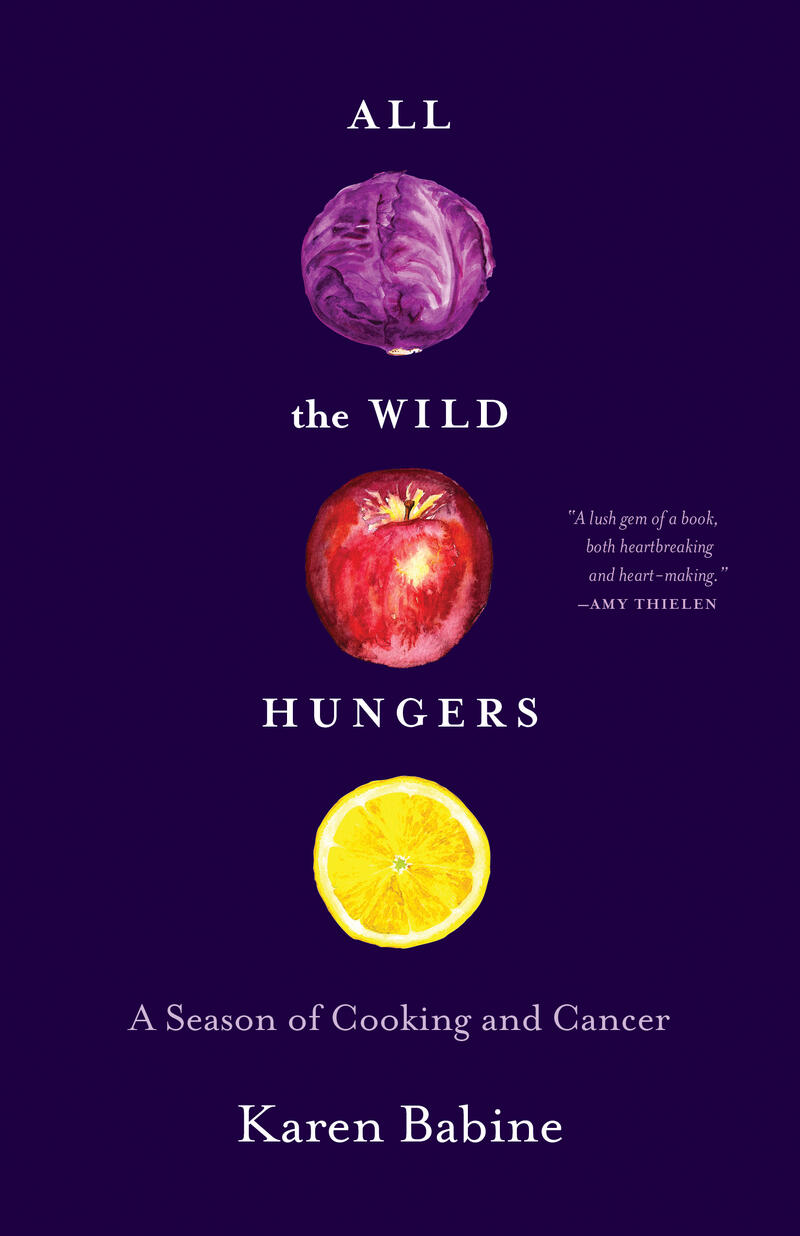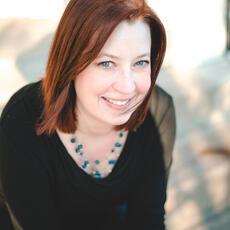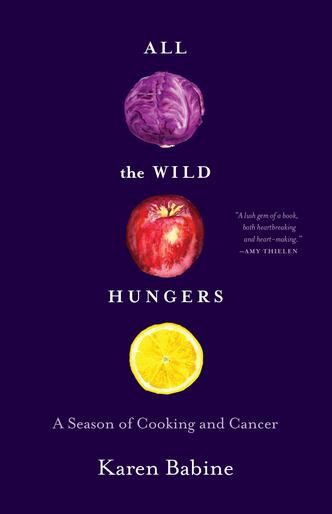5 Reasons to Teach This Book: All the Wild Hungers
Welcome, friends, to the latest installment of 5 Reasons to Teach This Book! In this interview series, we examine what we can learn from Milkweed’s titles by discussing our books with educators, authors, and booksellers. This month, we’re featuring Karen Babine’s 2020 Minnesota Book Award winning book, All the Wild Hungers: A Season of Cooking and Cancer.
In this interview, Karen and I discuss both the craft and critique of personal nonfiction. What on the page contributes to an author’s voice, that borderline indefinable element of craft? How do we accommodate our eagerness for answers in literature without rushing to meet them at the end—and potentially overlooking crucial subtleties? Why are food and writing such particular cousins? Addressing these areas of inquiry with Karen feels much like reading her micro-essays: percussive, compelling, and eye-opening. As she does in her own writing, Karen guides us towards “the point where Story becomes Experience” in a series of enthralling responses I am immensely pleased to share with you all. Read on and enjoy!

Bailey Hutchinson: As a writer (and food lover) myself, I have always been drawn to recipes. I know many other writers who feel similarly. All the Wild Hungers is punctuated with them, peppered with ingredient lists and instructive culinary moments—could you speak to your relationship with the recipe as a form, as a generative tool, as whatever role it plays in your writing process?
Karen Babine: I love how recipes are such a snapshot of their time and place. They’re so individual to the person who wrote them, what they assume their audience will know, and what’s really interesting to me is how place-specific they are. I love cookbooks, particularly old church cookbooks, and I’ve started to buy cookbooks when I travel—I have a couple of good ones from my trip to Nova Scotia a few years ago that are fun, though my access to fiddlehead ferns is very limited here in Chattanooga. I have the 1949 cookbook from Faith Lutheran Church in Forest Lake, MN, which is where my grandmother grew up—and the second recipe is my great-grandmother’s recipe for Scalded Rye Bread, and it’s so sparse, and assumes so much about the cook, that I’ve never been able to decode it and make it.
I once did a project trying to see what similarities there were between the Swedish rice pudding of my Minnesotan childhood—risgrynsgröt—and the Swedish rice pudding of the Swedes in Nebraska where I was living at the time, which was always risgrynskaka. Same root recipe, but the Minnesota recipe is almost always a stovetop recipe and in Nebraska, it’s baked. I eventually started to wonder if it had to do with fuel sources and what was available. When I teach food writing, whether it’s composition or senior seminar, my favorite activity is to have students introduce themselves with their favorite food or recipe. The last time I taught composition, that recipe became the research project for their entire semester. They researched its history, interviewed their grandmothers or other family experts, and argued its importance to their community. I got research papers on jollof rice, maple syrup, chocolate chip cookies. One student whose family was Guyanese wrote about her family’s favorite curry dish—and she had to research how Indian food got to South America. It was a fascinating assignment and really underscored personal experience and oral history as essential facets of research, and research as an extension of curiosity.
BH: On every readthrough of your book, I am always caught by this moment: “What I’ve learned is that the anise dissolves into the bread after a day or so, making it well worth the wait to cut into the loaf, but I rarely have the self-control. My stomach muscles clench, tighten, as if I haven’t eaten in days. There’s so much I want to know, to understand about what is happening to my mother” (62). I think this speaks, too, to the way we parse literature, eager for answers. How can we manage this impulse as readers?
KB: As a nonfiction writer, there’s great power in unknowing, in Montaigne’s famous “what do I know?”—and what happens when the answer is I have no idea. The beauty of essays is in how my undergrad professor described them, as “the witnessed development of an idea.” We come to essays to see the work of the writer on the page, wrestling with something that doesn’t quite fit. There’s mental friction, or emotional tension, or just plain wonder that the universe created this moment in just this way. To me, it’s a great exercise in paying attention, because that’s what the best nonfiction does—it pays attention. It’s in search of meaning, in search of answers, but if there are none to be found, that’s as valuable.
I love research—there’s a lot of science, philosophy, religion, and such in All the Wild Hungers—and research is always the work of curiosity for me. I love getting lost in Wikipedia links or just wandering down the shelf of a library and seeing what other books are next to the one I went in to find. I love the intersection of things, the moment where things become just a little more clear, like knowing that the 1940 storm that took down the Tacoma Narrows Bridge—Galloping Gertie—in Washington became the storm that became the Armistice Day Blizzard in Minnesota, a blizzard that still lingers in our collective regional imagination.
BH: What advice do you have for bringing personal nonfiction into the classroom? Are there challenges to teaching texts deeply rooted in the personal?
KB: I’m of a couple of minds about this. One comes out of a recent project of mine—a taxonomy of nonfiction—that’s come out of a desire to be more precise in how we talk about the nonfiction page. As a writer, I want to know what makes a piece of writing tick. I want to see its gears, its wires. As a teacher, I want to move towards being more precise in how we talk about a page, because memoir has become shorthand for any nonfiction that’s personal or uses the first person pronoun. All the Wild Hungers isn’t memoir—it’s flash essays—but that said, if someone is convinced it’s memoir, I would be fascinated to hear their thinking. I think of the micro-essays of All the Wild Hungers like an accordion—they’re doing in flash form what I usually do in a 15-20 page essay form. I wanted to see what would happen if I compressed this form to such a small space, that if I pulled the accordion out, it would look like my other essays. That was my thinking, but a reader will always have their own take—and that’s a great start for conversation. Something like this taxonomy should always be used to foster conversation, not squash it. I love getting into the nuts and bolts of the genre—it’s so fascinating.
The second part goes back to a favorite quote—the Hmong memoirist Kao Kalia Yang once quoted her father, Bee, who said that the human life is individual, it is not unique. All the Wild Hungers really started as one odd object essay about my love for my skillet and the weird thing my mom’s doctors said. Good nonfiction always starts with an itch. But I kept coming back to this idea that I’m not the first person whose mom has had cancer—and so there had to be something else on the page to make it relevant to readers who don’t know me, don’t know Mom. I love essays, as a form, because if I look at my life as a subject, I have a finite amount of things to write about. In essays, my life and my experiences become a lens to view the world and I have infinite pages in front of me. In this book, the lens was food.
I’m always reaching for the point where Story becomes Experience, where we move from here’s this thing that happened to here’s what fundamental thing about human I want to say about it. Am I trying to say something about alienation, joy, wonder, horror? How can I reach for the universal in the specific?
BH: What other Milkweed books would you include on a syllabus built around All the Wild Hungers?
KB: Ooh, this is a fun question. I’ve taught Beth Dooley’s In Winter’s Kitchen in a food class—such an incredible book. I’d love to pair All the Wild Hungers with Lee Ann Roripaugh’s Dandarians or Amy Leach’s Things That Are, for the way they layer language on top of language to create meaning. That would be a fun conversation about flash, the compression of the page, and what you can do in a small space. Paul Gruchow (Boundary Waters, in particular) taught me how to write a sentence and how to value the place where I am—that Minnesota, that the rural, that the everyday is just as valuable as elsewhere and exciting. An odd pairing might be with Tim Robinson’s Listening to the Wind, a writer who, until Covid-19 took him and his wife in April (within two weeks of each other), was my favorite living essayist. That man was unmatched in his brilliance. I’ve loved him for years and he’s virtually unknown on this side of the Atlantic, which is tragic. Pairing Robinson’s essays with my micro-essays could be a really interesting conversation and then let’s just spend hours talking about the glory of Robinson’s sentences. I also love the way he layers research, personal experience, interviews, characters, history, geology, culture, and more into the meanderings of his feet. Joni Tevis does this in The World is On Fire too. There’s a lot of that—albeit in a smaller space—in All the Wild Hungers.
BH: One of the most captivating things about your book is—for me, at least—your voice. It’s got a smooth, steady timbre that neither quashes joy or masks grief; it’s balanced, while still making room for big feelings. How do you hone this kind of balance?
KB: Last fall I did an interview with Julija Sukys in which she said that for as personal as All the Wild Hungers is, you never get to know me very well. That’s deliberate—my narrative distance, that is, the distance between the narrator and the subject, is very tightly controlled. I’m always going to keep some parts of myself private. The book ends with my mother cancer free—as she was immediately after her surgery—but it’s common knowledge now that the cancer came back and she passed away in November 2018. Three days before she died, she was well enough to go out to dinner at my favorite restaurant with the family for my 40th birthday. I’m never going to write about that. I’m never going to write her last hours, being there when she died. There’s a lot about those hours I’ve never even said out loud.
I had this moment of insight last fall, when I was reading Irish travel writer Dervla Murphy’s first book, Full Tilt, about her solo bicycle trek from Ireland to India in 1963, and her voice is incredibly distant, almost clinical. We get very little of how she feels, or even what she thinks. It’s really fascinating. I had a student come to my office and she was a bit troubled, because she suspected that her rape was relevant to the piece she was writing on public art, but she didn’t really want to get into it. I knew what she meant, so I handed her Murphy, flipped to the page where Murphy is nearly raped in Azerbaijan. The event occupies less than a paragraph and the closest readers get to a reaction is Murphy’s observation that she’ll never go back to Azerbaijan alone. You control how much a reader knows, I told my student. You’re never required to go further than that.
But I’m also deeply, passionately in love with sentences. I love playing with them, stretching them like taffy, taking a knife to them and squaring off the edges. You can’t have voice without sentences. I love the opening to Michele Morano’s essay “The Queimada,” which is the opposite end of the narrative distance spectrum: there’s no distance between the narrator and the subject. She wants the reader right there, at the table, tasting, chewing, surrounded by candlelight and the kind of drowsy you can only get when you’re surrounded by good food and good friends. And she uses her sentencing to put readers there.

